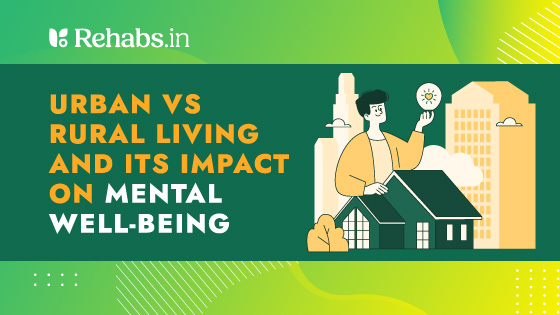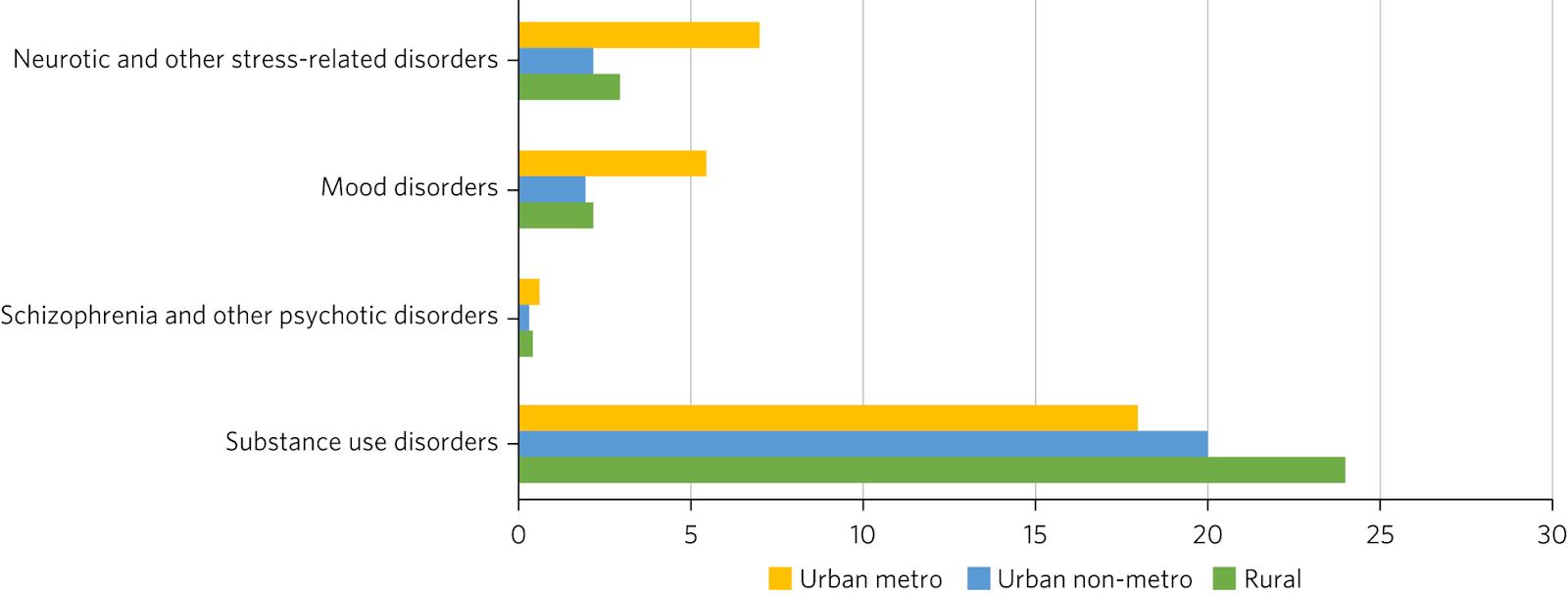Urban vs rural living and its impact on mental well-being

In today’s fast-paced world, it’s common for people to move away from their hometowns and their families, for work or study. Just a generation or two ago, this was far less typical. If your parents or grandparents live in a rural area, you’ve probably noticed just how different their lifestyle is. Maybe you’ve even come across dreamy Instagram reels romanticizing “slow rural life.”
But beyond the aesthetics, is rural life actually better for our mental health than urban living? And more importantly, how can we find balance and carve out moments of slowness even in the middle of city chaos? Let’s talk about it in this blog.
Why does where you live matter?
Our environment influences everything from our stress levels and sleep quality to our access to healthcare and sense of community. The pace of life, noise levels, social networks, and even how much green space we see daily can all shape how we feel, think, and cope.
In recent years, mental health concerns have been rising steadily across both urban and rural settings. While cities report higher rates of anxiety and burnout, rural areas often struggle with limited access to mental health services and increased social isolation. This makes it clear that mental health challenges don’t discriminate based on geography but the way they show up can differ.
Are urban cities better for our mental health?
Cities offer excitement, opportunity, and convenience but they can also be mentally exhausting. Urban living is often associated with better access to jobs, education, entertainment, and healthcare, including mental health services. The fast pace and diversity of city life can foster creativity, ambition, and connection for many.
However, these benefits often come at a cost to mental well-being. Living in densely populated areas can increase exposure to constant noise, crowded spaces, traffic, and pollution all of which can heighten stress and fatigue. Studies have shown that individuals living in urban areas are more likely to experience anxiety, depression, and burnout compared to their rural counterparts.
Some of the common mental health challenges of urban living include:
- Chronic stress and sensory overload: Constant stimulation from noise, screens, traffic, and crowds can keep the nervous system in a state of hyper-arousal.
- Social isolation despite proximity: Ironically, being surrounded by people doesn’t always translate to meaningful connection, leading to feelings of loneliness.
- Burnout culture: The pressure to hustle, be productive, and keep up with rising costs of living can lead to emotional exhaustion.
- Limited access to nature: Reduced exposure to green spaces has been linked to higher rates of mood disorders and decreased emotional regulation.
- Digital overstimulation: The always-on culture, social media comparison, and lack of downtime contribute to cognitive fatigue and poor sleep.
Is rural living better for our mental health?
Rural life is often portrayed as peaceful, slow-paced, and deeply connected to nature and for many, that image holds true. The quiet environment, open spaces, and strong sense of community in rural areas can offer significant mental health benefits. Being closer to nature has been shown to reduce stress, improve mood, and support emotional regulation. Many people living in rural settings report feeling more grounded and less overwhelmed compared to those in urban areas.
Here are some mental health benefits often associated with rural living:
- Stronger community ties: Rural communities often foster closer-knit relationships, where people look out for one another and social interactions are more personal and meaningful.
- Proximity to nature: Regular exposure to greenery, fresh air, and natural surroundings supports lower cortisol levels, better sleep, and improved emotional well-being.
- Slower pace of life: The reduced rush and pressure may create space for reflection, rest, and deeper connection to daily life.
- Lower noise and light pollution: A quieter environment is more conducive to rest and mental recovery.
However, rural living also comes with its own set of mental health challenges:
- Limited access to mental health care: Fewer therapists, psychiatrists, and mental health clinics can delay treatment or make it harder to find specialized care.
- Stigma around mental illness: In smaller communities, there can be a fear of judgment or breach of privacy, leading to reluctance in seeking help.
- Isolation and fewer social opportunities: Especially for young people or those living alone, the lack of social outlets can contribute to feelings of loneliness.
- Economic uncertainty: Limited job prospects and financial strain can affect self-esteem and stress levels, particularly in agricultural or underdeveloped regions.
- Conservative social structures: In many rural settings, societal norms may be more patriarchal or orthodox, which can restrict opportunities for women and marginalized groups, impacting autonomy, access to education, and mental health.
What does research say?
The National Mental Health Survey (NMHS) of India (2015–2016) highlighted significant differences in the prevalence and types of mental disorders across urban and rural areas. Mental disorders were nearly twice as common in urban areas (13.5%) compared to rural areas (6.9%), particularly mood disorders, neurotic/stress-related conditions, and schizophrenia.
However, rural populations reported a higher burden of substance use disorders, especially involving alcohol and tobacco. Despite the lower prevalence of other disorders in rural regions, the treatment gap remains vast, ranging from 70% to 92% due to limited awareness, poor infrastructure, and lack of access to mental health professionals. These findings underscore the complexity of the mental health landscape in India, where urban living is linked to higher stress and psychiatric morbidity, while rural areas face serious challenges in terms of care delivery, stigma, and affordability.

Image Source:: Mathur, R., Chawla, N., & Chadda, R. K. (2024). Mental health services in rural India: a big challenge still to be met. BJPsych International, 21(4), 93–96. doi:10.1192/bji.2024.25
Urban Living and Mental Health Risks
Studies consistently show that people living in urban areas are at a higher risk of experiencing mental health issues like anxiety, depression, and mood disorders. A large-scale meta-analysis published in Nature found that urban living is associated with increased activity in the amygdala, the part of the brain linked to stress and fear response, compared to rural living. This suggests that chronic urban stressors, such as overcrowding, noise, and social tension, may lead to heightened emotional reactivity (Lederbogen et al., 2011).
Rural Areas and Barriers to Care
On the flip side, while rural residents may report lower levels of anxiety or sensory overload, they often face greater barriers to accessing timely and quality mental health care. The World Health Organization (WHO) has noted that rural populations globally face a shortage of trained professionals, longer travel times to clinics, and limited awareness about mental health services.
In India, a 2016 study by the National Institute of Mental Health and Neurosciences (NIMHANS) found that rural areas had a mental health treatment gap of over 80%, largely due to lack of services, awareness, and persistent stigma.
Importantly, researchers caution against viewing either setting as inherently “better.” A 2022 review in BMC Public Health emphasized that mental health is influenced by a complex interplay of factors including social support, financial stability, gender roles, and cultural norms, many of which can vary significantly even within urban or rural populations.
Writer’s Perspective: Finding Balance Between Two Worlds
In today’s world, many of us don’t have the luxury of choosing where we live based purely on what supports our mental well-being. Financial stability, job opportunities, family responsibilities, and safety often take priority over geographic preferences.
As someone who grew up in a small town and later moved to a big city, I’ve experienced the mental health highs and lows of both settings. Smaller towns often foster a sense of community, you know your neighbors, people look out for each other, and life moves at a gentler pace. But as a woman, I also felt the weight of traditional expectations and restrictions. In many rural areas, societal structures still lean toward being more patriarchal, which can limit personal freedom and opportunity.
City life, on the other hand, gave me the freedom to explore who I am and to live on my own terms. It pushed me to grow, adapt, and discover parts of myself I might never have found otherwise. But that freedom comes with a cost. You’re often navigating everything alone, sometimes in a place where you don’t speak the local language, where things move fast, and life feels more transactional. Yet, cities also offer accessibility, modern amenities, and the possibility of higher living standards.
Through it all, I’ve come to believe that mental well-being isn’t just about where you live, it’s about how you live. In a rural setting, that might mean creating space for self-discovery despite limited external options. In an urban setting, it might mean deliberately slowing down to notice and savor the small, grounding moments. No place is perfect, but we can always find ways to nurture ourselves, wherever we are.
How to thrive regardless of where you are
Whether you’re surrounded by skyscrapers or fields, mental well-being is something you can nurture with intention. While our environments shape us, they don’t define us. Here are some ways to support your mental health, no matter where you call home.
Build your own support system
If you’re in a rural area with limited resources, reach out to online therapy platforms, helplines, or support groups. In cities, even though services are available, finding people who truly get you can take effort, so focus on building a few meaningful connections over many surface-level ones.
Create moments of stillness
City dwellers often need to slow down intentionally, whether that’s taking a quiet walk, meditating, or just drinking your tea without distractions. In rural areas, where things may already be slower, carve out space for reflection, journaling, or creative expression.
Stay connected to nature
Nature is one of the most powerful tools for mental well-being. If you’re in a rural area, lean into it, take daily walks, garden, or spend time outdoors. If you’re in a city, seek out green spaces, even small ones. A balcony with plants, a local park, or a weekend nature escape can work wonders.
Conclusion
Where we live can shape our mental health in powerful ways but it’s not the only factor that matters. Both urban and rural environments come with their own set of benefits and challenges, and neither is inherently better or worse. What truly makes a difference is how we care for ourselves within those settings whether that means seeking support, slowing down, building connection, or creating space for growth. By understanding our environment and tuning into our personal needs, we can learn to thrive, wherever we are.
Sources:
Lederbogen, F., Kirsch, P., Haddad, L., Streit, F., Tost, H., Schuch, P., & Meyer-Lindenberg, A. (2011). City living and urban upbringing affect neural social stress processing in humans. Nature, 474(7352), 498–501. https://doi.org/10.1038/nature10190
National Institute of Mental Health and Neurosciences (NIMHANS). (2016). National Mental Health Survey of India, 2015–16: Summary. Bengaluru: NIMHANS Publication.
Mathur, R., Chawla, N., & Chadda, R. K. (2024). Mental health services in rural India: a big challenge still to be met. BJPsych International, 21(4), 93–96. doi:10.1192/bji.2024.25
World Health Organization. (2021). Mental health in primary care: Illusion or inclusion? WHO South-East Asia Region. https://www.who.int/publications/i/item/9789290228423
Berg, A., & Berman, G. (2022). Urban-rural disparities in mental health: A systematic review. BMC Public Health, 22(1), 1–13. https://doi.org/10.1186/s12889-022-13078-3















